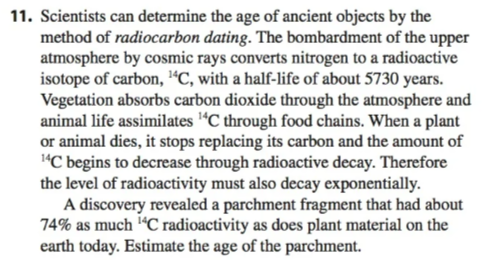12. Dinosaur fossils are too old to be reliably dated using carbon-14. (See Exercise 11.) Suppose we had a 68-million- year-old dinosaur fossil. What fraction of the living dino- saur's ¹C would be remaining today? Suppose the minimum detectable amount is 0.1%. What is the maximum age of a fossil that we could date using ¹4C?
12. Dinosaur fossils are too old to be reliably dated using carbon-14. (See Exercise 11.) Suppose we had a 68-million- year-old dinosaur fossil. What fraction of the living dino- saur's ¹C would be remaining today? Suppose the minimum detectable amount is 0.1%. What is the maximum age of a fossil that we could date using ¹4C?
Algebra & Trigonometry with Analytic Geometry
13th Edition
ISBN:9781133382119
Author:Swokowski
Publisher:Swokowski
Chapter5: Inverse, Exponential, And Logarithmic Functions
Section: Chapter Questions
Problem 78RE
Related questions
Question

Transcribed Image Text:12. Dinosaur fossils are too old to be reliably dated using
carbon-14. (See Exercise 11.) Suppose we had a 68-million-
year-old dinosaur fossil. What fraction of the living dino-
saur's ¹4C would be remaining today? Suppose the minimum
detectable amount is 0.1%. What is the maximum age of a
fossil that we could date using ¹4C?

Transcribed Image Text:11. Scientists can determine the age of ancient objects by the
method of radiocarbon dating. The bombardment of the upper
atmosphere by cosmic rays converts nitrogen to a radioactive
isotope of carbon, ¹C, with a half-life of about 5730 years.
Vegetation absorbs carbon dioxide through the atmosphere and
animal life assimilates ¹4C through food chains. When a plant
or animal dies, it stops replacing its carbon and the amount of
14C begins to decrease through radioactive decay. Therefore
the level of radioactivity must also decay exponentially.
A discovery revealed a parchment fragment that had about
74% as much ¹4C radioactivity as does plant material on the
earth today. Estimate the age of the parchment.
Expert Solution
This question has been solved!
Explore an expertly crafted, step-by-step solution for a thorough understanding of key concepts.
This is a popular solution!
Trending now
This is a popular solution!
Step by step
Solved in 3 steps with 2 images

Recommended textbooks for you

Algebra & Trigonometry with Analytic Geometry
Algebra
ISBN:
9781133382119
Author:
Swokowski
Publisher:
Cengage


Glencoe Algebra 1, Student Edition, 9780079039897…
Algebra
ISBN:
9780079039897
Author:
Carter
Publisher:
McGraw Hill

Algebra & Trigonometry with Analytic Geometry
Algebra
ISBN:
9781133382119
Author:
Swokowski
Publisher:
Cengage


Glencoe Algebra 1, Student Edition, 9780079039897…
Algebra
ISBN:
9780079039897
Author:
Carter
Publisher:
McGraw Hill


Trigonometry (MindTap Course List)
Trigonometry
ISBN:
9781337278461
Author:
Ron Larson
Publisher:
Cengage Learning